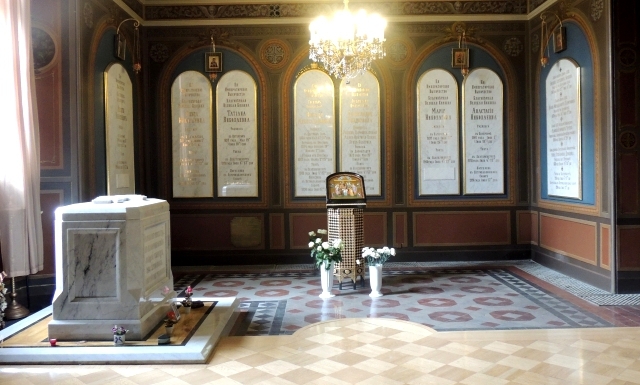Nicholas II
Nikolai Alexandrovich was in the opinion of his contemporaries more like his mother than like his father. He inherited from her not only the color of his eyes, his small height and regular features of his face but also his shyness, kindness and mild character and unfortunately a lack of will that caused to the collapse of his reign.
The Tsesarevich Nicholas with all his intellect and good education lacked an ability to foresee the situation, firmness and core so necessary for the monarch of huge and complicated Russia.
Bright and Dark Days of the Happy Marriage
The marriage of Nicholas and Princess Alice of Hesse (a granddaughter of Queen Victoria of England) who accepted Orthodoxy with the name of Alexandra Fiodorovna was based on mutual all-encompassing love.
First they had 4 daughters: Olga, Tatyana, Anastasia, Maria and at last in 1901 the long awaited heir Alexis to the throne came into the world.
The Tsesarevich was named Alexei. Alexei was called ”our little treasure” in the Imperial Family. During the first months of the heir’s life it seemed that nothing could darken general happiness. But it suddenly turned out that the baby inherited from his mother - hemophilia, a disease that was mortal at the beginning of the 20th century.
Grigory Rasputin - the Last Hope of the Family
 The desperate Empress tried to use any chance even resorting to mystical means to help her son in some way.
The desperate Empress tried to use any chance even resorting to mystical means to help her son in some way.
It was then in 1905 that Grigori Rasputin, a mystic, appeared in the Royal Family, who increased however a gap between the imperial couple and the entire country.
For the Emperor Nicholas II and Empress Alexandra, the man was a “good genius” who could restrain the small Alexei’s disease. Tsesaevich Alexei was a clever and agile boy full of lofty enthusiasm and ardent spirit.
Despite the grave illness when any aggravation could bring death they were preparing the Tsesarevich for the role of monarch from his easy childhood. He attended parades, reviews, receptions and military festivals.
Russian Revolution of 1917 - Siberian Exile
During the night of 2 March 1917 Nicholas II, Emperor of Russia was forced by Russian Provisional Government to sign abdication from the throne due to the Russian Revolution that put an end to Monarchy in Russia. That moment marked the start of the way “to Calvary” for the Royal Family.
They were kept under home arrest at Tsarskoe Selo. Their conditions were quite severe: isolation from the outside world and a guard all the time during promenades. Later at the decision of the provisional Government the Romanov Family was exiled to the remote Siberian town of Tobolsk and then in April 1918 they were transferred to Ekaterinburg.
And Who's To Judge
In Ekaterinburg Emperor, Empress and all their children as well as their attendants were fiercely murdered in July 1918 in the Ipatyev Mansion by the order of the Bolshevic Government and were secretly buried in a forest near Ekaterinburg.
The heir Alexei was only 14 when that happened. When they were announced to be condemned to death Nicholas said to executors: “You know not what you do”
In 1998 the remains of the Tsar Nicholas, his family members and servants found near Ekaterinburg, a town in Russia were identified and on 17 July, 80 years after their tragic death they were buried in the St Peter and Paul Cathedral, at the family sepulcher of the Russian Emperors.
Guided Tour to Peter and Paul Fortress in St Petersburg will give you chance to learn how it was. After 80 years Nicholas II and his family were recognized as saints by the Russian Orthodox Church.







